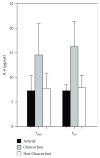Markers of Local Inflammation and Bone Resorption in the Acute Diabetic Charcot Foot
- PMID: 30155488
- PMCID: PMC6098852
- DOI: 10.1155/2018/5647981
Markers of Local Inflammation and Bone Resorption in the Acute Diabetic Charcot Foot
Abstract
Objective: Due to the localized nature of Charcot foot, systemically altered levels of inflammation markers can be difficult to measure. The aim of this study was to investigate whether it is possible to detect an arteriovenous (A-V) flux in any locally produced inflammatory biomarkers from an acute Charcot foot by comparing local and systemic measurements.
Methods: We included patients with acute diabetic Charcot foot. Blood was sampled from the vena saphena magna on the distal part of the crus bilaterally as well as from the arteria radialis. To minimize the A-V shunting effect, the feet were externally cooled with ice water prior to resampling.
Results: Both before and after cooling, the A-V flux of interleukin-6 (IL-6) between the Charcot feet and the arterial level was significantly higher than the flux between the healthy feet and the arterial level (Δvaluebefore: 7.25 versus 0.41 pg/mL, resp., p = 0.008; Δvalueafter: 10.04 versus 1.68 pg/mL, resp., p = 0.032). There were no differences in the fluxes for other markers of inflammation.
Conclusion: We have found an increased A-V flux of IL-6 in the acute diabetic Charcot foot compared to the healthy foot in the same patients.
Figures


Similar articles
-
Bone mineral density and markers of bone turnover and inflammation in diabetes patients with or without a Charcot foot: An 8.5-year prospective case-control study.J Diabetes Complications. 2018 Feb;32(2):164-170. doi: 10.1016/j.jdiacomp.2017.11.004. Epub 2017 Nov 11. J Diabetes Complications. 2018. PMID: 29196119
-
Normal blood flow response and vasomotion in the diabetic Charcot foot.J Diabetes Complications. 1998 May-Jun;12(3):147-53. doi: 10.1016/s1056-8727(97)00080-9. J Diabetes Complications. 1998. PMID: 9618070
-
Inflammatory and bone turnover markers in a cross-sectional and prospective study of acute Charcot osteoarthropathy.Diabet Med. 2015 Feb;32(2):267-73. doi: 10.1111/dme.12590. Epub 2014 Oct 17. Diabet Med. 2015. PMID: 25251588
-
Diabetic foot: Charcot neuropathic osteoarthropathy.Adv Skin Wound Care. 2009 Feb;22(2):72-3. doi: 10.1097/01.ASW.0000345289.36026.cf. Adv Skin Wound Care. 2009. PMID: 19155710 Review. No abstract available.
-
Charcot foot in diabetes: farewell to the neurotrophic theory.Horm Metab Res. 2006 Jun;38(6):361-7. doi: 10.1055/s-2006-944525. Horm Metab Res. 2006. PMID: 16823717 Review.
Cited by
-
Controversies in the management of active Charcot neuroarthropathy.Ther Adv Endocrinol Metab. 2023 Apr 17;14:20420188231160406. doi: 10.1177/20420188231160406. eCollection 2023. Ther Adv Endocrinol Metab. 2023. PMID: 37101723 Free PMC article. Review.
-
[The role of glycation end products in the development and progression of diabetic neuroarthropathy].Probl Endokrinol (Mosk). 2021 Jul 4;67(3):4-9. doi: 10.14341/probl12778. Probl Endokrinol (Mosk). 2021. PMID: 34297497 Free PMC article. Review. Russian.
-
Novel Biomarkers Predictive of Diabetic Charcot Foot-An Overview of the Literature.Life (Basel). 2022 Nov 21;12(11):1944. doi: 10.3390/life12111944. Life (Basel). 2022. PMID: 36431079 Free PMC article. Review.
-
Diabetic polyneuropathy: Progress in diagnostic strategy and novel target discovery, but stagnation in drug development.J Diabetes Investig. 2020 Jan;11(1):25-27. doi: 10.1111/jdi.13188. Epub 2019 Dec 22. J Diabetes Investig. 2020. PMID: 31755662 Free PMC article.
-
Electrodiagnostic evidence of nerve regeneration in patients with diabetic Charcot foot treated with proximal tibial cortex transverse distraction.Jt Dis Relat Surg. 2025 Apr 9;36(2):430-436. doi: 10.52312/jdrs.2025.1929. Epub 2025 Apr 9. Jt Dis Relat Surg. 2025. PMID: 40235423 Free PMC article.
References
MeSH terms
Substances
LinkOut - more resources
Full Text Sources
Other Literature Sources
Medical

